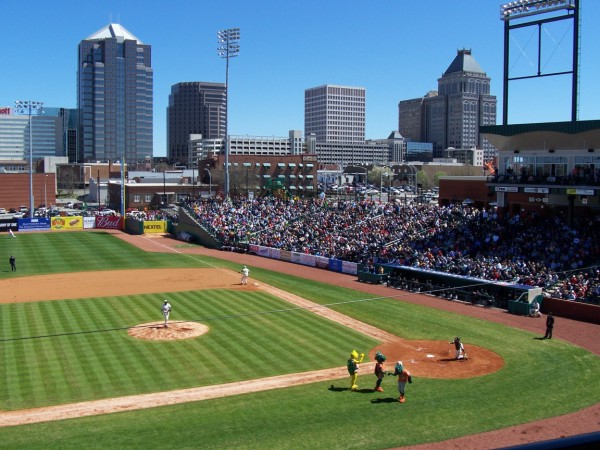On Saturday night (July 23) the Greensboro Grasshoppers bested the Hickory Crawdads, 7-6, in a South Atlantic League tilt. It was a fun game to watch, featuring several lead changes and six home runs, two by Hoppers catcher Endy Rodriguez.
Hickory had a relief pitcher (a righty) named John Matthews, with a conventional overhand delivery, but who occasionally dropped down to throw a sidearm breaking pitch to right-handed batters. This seems like an old-school maneuver to me, varying your motion -- like something modern pitchers tend not to do. Am I wrong?
Greensboro is familiar to me; it felt nice to come for a visit, like dropping in on an old friend. My mother lived here for several years, working in the admissions office at Guilford College, and Angela and I have had friends who grew up here or who settled here. It's got textile manufacturing in its DNA, like every N.C. Piedmont city. But the economy here is pretty diverse: finance, media, education.
There was an important Revolutionary War battle fought here, at Guilford Courthouse. For many years, due to that connection, Greensboro's ballclub was called the Patriots. Greensboro has a rich professional baseball history, beginning in 1902. Early on, the team played at Cone Athletic Park, named for Cone Mills. From 1926 their home field was World War Memorial Stadium. When they got a new ballpark in 2005, they got a spiffy new nickname: the Grasshoppers.
For quite a few years Greensboro was a Yankees affiliate, and the heart of the great Yankees teams of the 1990s-2000s played here, including Derek Jeter, Mariano Rivera, Andy Pettitte, Jorge Posada.
First National Bank Park is handsome. I like the downtown location. It seats 7,500, which would support the team playing at a higher level than its current classification in the High-A Sally League. The photo is not quite up to date: FNB has built an office building adjoining the park on the first base side, and there are newish apartments across the street behind the outfield fence. One could sit on one's balcony and watch games, if one were so inclined.
We splurged on good seats, behind home plate, which were comfortable and shaded. Foods consumed were gyros (quite good!) and soft-serve ice cream (tasty but a little more than we needed). Beer enjoyed was an Asheville brew, the Wicked Weed Appalachia Sessions IPA.
Here is the baseball heroes' gallery for Greensboro and Guilford County One family stands out. There are a couple of melancholy stories in here.
- Rick Ferrell (1905-1995) was an outstanding defensive catcher and a decent hitter, an eight-time AL All-Star. He is in the Baseball Hall of Fame; some people think they chose the wrong Ferrell brother. Rick spent many years in the Detroit Tigers' front office, where he was widely known and admired.
- Wes Ferrell (1908-1976) recorded 193 wins, 128 losses in 15 seasons in the majors, mostly the AL. He and Rick were teammates from 1934 to 1938 with the Red Sox and Senators. Arguably the best hitter of any MLB player, ever, who was primarily a pitcher. After his pitching days were over, Wes recorded some good seasons as an outfielder in the minors. His final season was with the Greensboro Patriots in 1949.
- A third Ferrell brother, George (1904-1987), had a long minor league career as an outfielder and third baseman. He played on the 1931 Greensboro Patriots in the Piedmont League, alongside future Hall of Fame slugger Johnny Mize. The 18-year-old Mize had a good season that year; George Ferrell had a better one.
- Jamestown native Pep Young (1907-1962) spent 19 seasons in professional ball, parts of 10 in the majors. He peaked in 1938, starting 149 games at second base for the NL runners-up Pittsburgh Pirates. He looks to have been a slick defender. His death certificate lists him as a shipping clerk for Oakdale Cotton Mills. Pep played for Oakdale's mill team at both the dawning and the twilight of his career.
- Bill DeLancey (1911-1946) caught every inning of the 1934 World Series for the St. Louis Cardinals as they defeated the Philadelphia A's. He was only 22, a favorite of Branch Rickey's, and seemed destined for a brilliant career. But DeLancey was plagued by respiratory issues, and died at a young age.
- Hal "Skinny" Brown (1924-2015) grew up in the Pomona Mills community in Greensboro. After his World War II service, he embarked on a 19-year pro career. Mostly in the majors, but I note he had some excellent years in the minors, including in the Pacific Coast League in the 1950s. Returned to Greensboro after his playing days and built a heating oil business.
- Tom Alston (1926-1993) was the first African-American to play for the St. Louis Cardinals, in 1954. However, his career was shortened by mental health issues, which plagued him the rest of his life. It's a sad story. The Cardinals come off poorly; they lagged behind other MLB clubs in integrating their roster, and their support of Alston was as a token, not as a human being. But also, we as a society were so backwards in our views of mental illness. We still have a long way to go.
Photo by Badbadb, provided under CC 2.5 license


